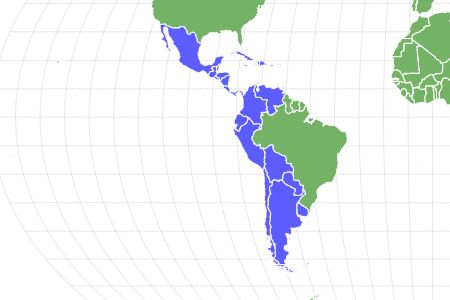Booby
Booby birds have a wingspan of around 5 feet
Advertisement
Booby Scientific Classification
Read our Complete Guide to Classification of Animals.
Booby Conservation Status
Booby Facts
- Lifestyle
- Flock
- Favorite Food
- Flying Fish
- Type
- Bird
- Average Clutch Size
- 2
- Slogan
- Seabirds found across the South Pacific!
“Booby birds have a wingspan of around 5 feet”
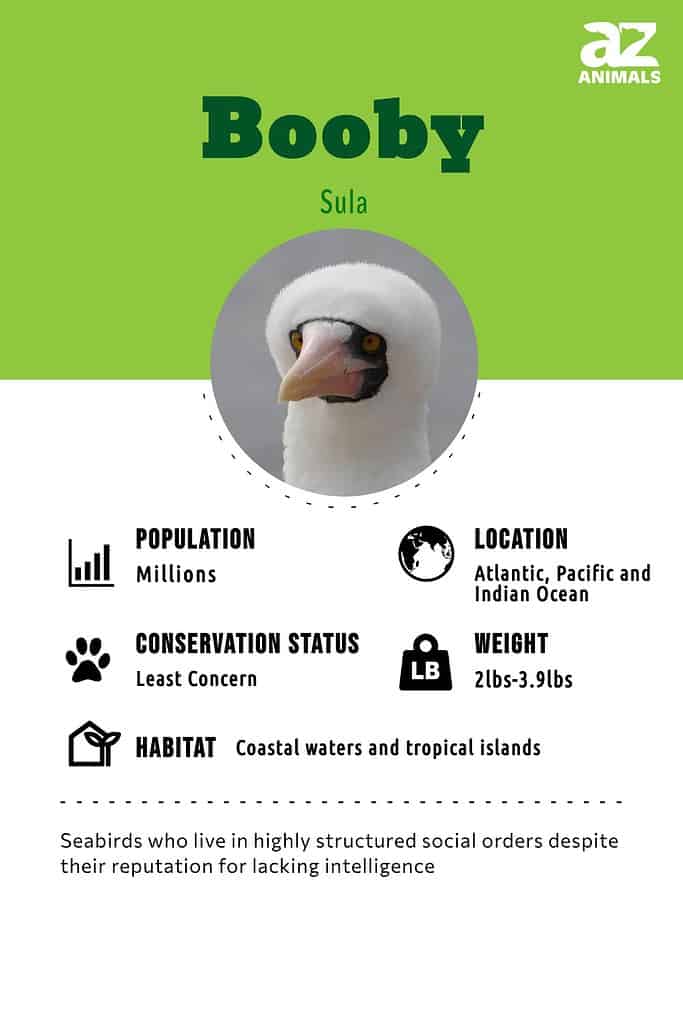
The booby is a seabird that lives in the coastal regions of Central and South America. Boobies are carnivorous birds that eat anchovies, mackerel, sardines, and squid. These feathered creatures appear awkward while walking on land but are excellent fliers and divers. They can live up to 17 years in the wild.
An Incredible Bird: 5 Booby Facts!

Booby birds mate for life.
©Jill L. Ferguson/Shutterstock.com
- The booby bird stays with the same partner for life
- A group, or colony, can include as many as 200 booby birds
- A booby bird that spots a fish in the ocean can dive from a height of 80 feet or more in the air
- The booby is similar in appearance to the gannet
- When this bird is getting enough vitamins and other nutrients, its feet remain deep blue or even purple in color.
Scientific Name
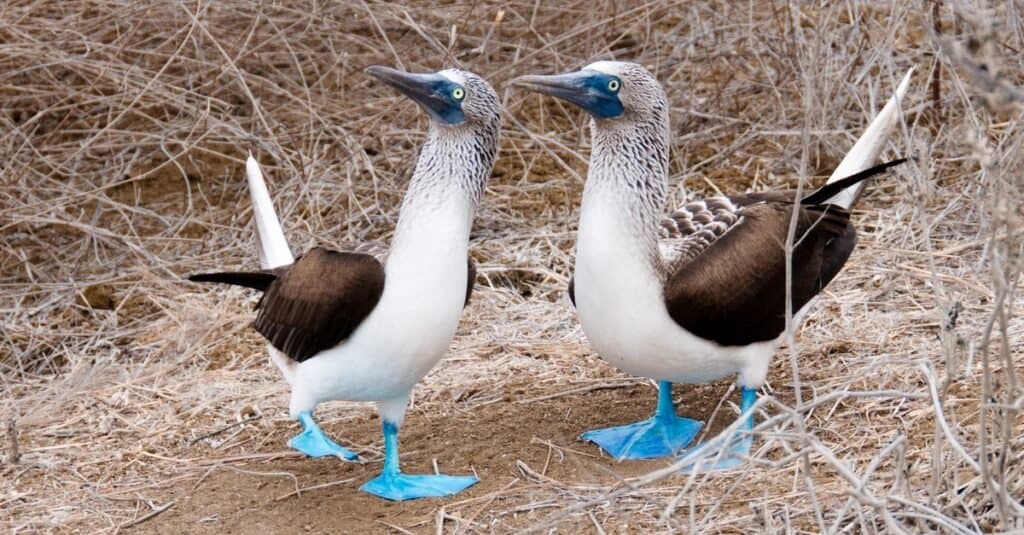
Boobies get their name from their clumsy, awkward behavior.
©tamara bizjak/Shutterstock.com
The scientific name of the blue-footed booby bird is Sula nebouxii. Its name comes from the Spanish slang term bobo. Bobo means foolish or clownish. When Spanish sailors observed the awkward way these feathered creatures walked and moved around on land, they called them bobos. Adding to their reputation for foolishness, these animals would land on Spanish ships making it easy for sailors to catch and eat them.
They belong to the Sulidae family and the class Aves.
There are six species of this seabird. They all belong to the Sula genus. These include:
- Blue-footed booby
- Masked booby
- Brown booby
- Red-footed booby
- Peruvian booby
- Nazca booby
Appearance & Behavior

The Masked Booby is easily mistaken for a gannet.
©Angela K. Kepler – Public Domain
A booby bird is 32 to 34 inches long with a wingspan of approximately 5 feet. Picture two and a half bowling pins stacked on top of one another and you have the same length as a 34-inch-long booby bird. When thinking about a wingspan of 5 feet, picture a length equaling one-fourth of a giraffe! These animals weigh a little over 3 pounds. A 3-pound booby bird is equal in weight to half a brick.
The appearance of this feathered creature differs according to its species. Of course, the blue-footed booby is known for its brightly colored feet. This species doesn’t start out with blue or purple feet from birth. The babies, or chicks, are born with white feet. Their feet don’t turn blue until they’re six months old. A brown booby doesn’t have blue feet. Instead, it’s known for the dark brown feathers on its back and head.
The masked booby is also called the masked gannet because it looks a lot like a gannet. Both have mostly white feathers with brown on their wings and tail. The masked booby gets its name because its feathers form a blue mask on its face.
The red-footed booby? You guessed it! It’s known for its bright red feet. It also has a pink and blue bill that sets it apart from other species of booby birds.
The Peruvian booby has brown feathers on its back and wings and a white underside. Alternatively, the Nazca booby has white feathers on its back and some brown on its feathers. Its beak is a combination of orange and pink.
This animal has two yellow, intense-looking eyes along with a serrated beak. The rough, sharp edges of its beak help this animal to grab onto the slippery fish that make up its diet.
The feet of a booby bird whether it’s the blue-footed, red-footed booby, or another species, serve a purpose (other than walking). Male blue-footed boobies show off their feet to attract a mate. Also, both male and females use their feet to cover their chicks in the nest.
The largest species is the masked booby. Its wingspan can be as much as 5 feet, 7 inches and it can weigh up to 5 pounds.
This animal is social and lives in a colony. There can be a dozen to hundreds of birds in a colony. A large number of birds in a colony can discourage predators from entering the area to try to steal from nests.
These creatures can make a lot of noise in the form of grunting, honking, and whistling. So, as you might guess, a colony of these animals is a very loud place to visit!
One of the most notable qualities of a blue-footed, red-footed, masked, or another type of booby bird is curiosity. If a human approaches this seabird, it’s not likely to be frightened. In fact, they have a reputation for landing on boats or other types of watercraft to check out the activity of the humans aboard!
These animals can be aggressive during mating season. For instance, if two males are competing for the attention of a female, then there may be some aggressive behavior between them. Otherwise, they are mostly non-aggressive animals with a curious nature.
Evolution
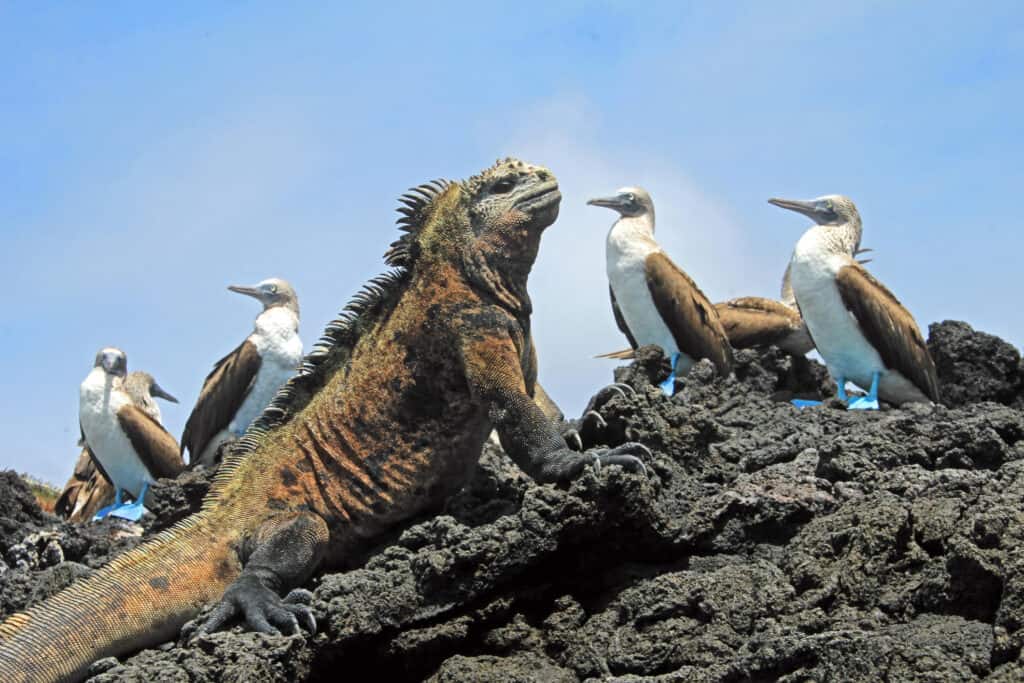
The blue-footed booby is found in large numbers on the Galapagos Islands.
©iStock.com/cicloco
Blue-footed boobies were one of the animals that helped spark Charles Darwin’s initial investigations into the theory of evolution during his trip to the Galapagos Islands in 1835. Their vibrant periwinkle paddles and exquisite diving techniques would be sure to dazzle anyone with a passion for animals. These birds which once were synonymous with the island have seen declining numbers at the birthplace of evolution in recent years. SInce boobies are what is known as bioindicator species, they will change their diet and habitat based on changing factors in their environment. While the blue-footed booby once had little interference from humans on the Galapagos, populations of people have been steadily increasing on the island since the 1970’s driving the birds away simultaneously. Even though these birds were instrumental in kickstarting the theory of evolution, little is known about their ancient history besides the fact that they diverged from a common ancestor sometime 200,000 years ago in Peru.
Habitat
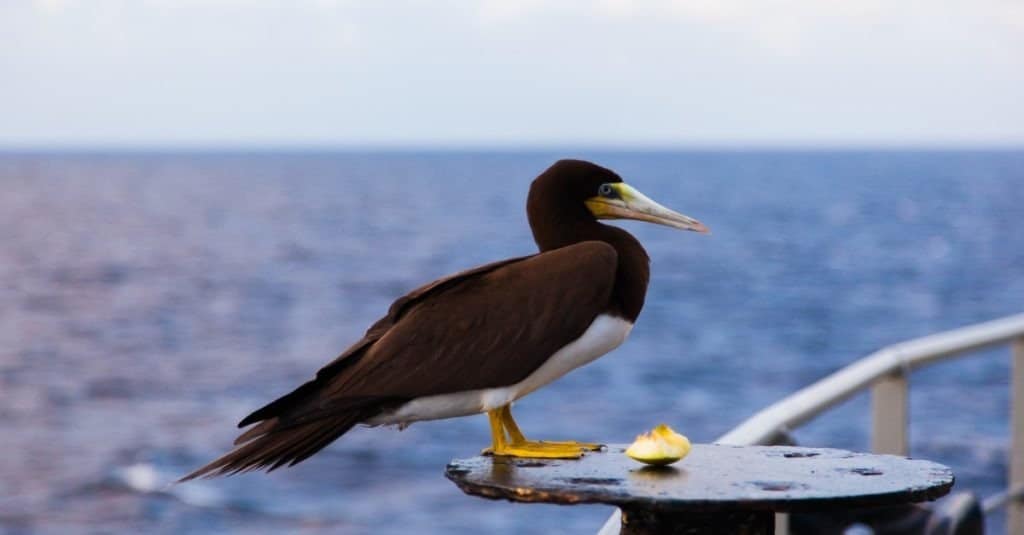
Boobies are known to be incredibly curious.
©ZHMURCHAK/Shutterstock.com
These are tropical creatures. The blue-footed booby lives in Central and South America, specifically on the western coasts. This species is abundant on the Galapagos Islands. The habitat of the brown booby includes the Gulf of Mexico, the Caribbean, Indian, and Pacific Oceans. The masked booby bird’s habitat includes large stretches of the Pacific Ocean.
This seabird stays in its colony on land throughout the night. During the day, it takes flight to hunt for fish in the ocean. Though these seabirds move in an awkward, unsteady way on land, they are expert fliers. When they spot a fish, they pull their wings flat, against their body as they begin a dive from 80 feet or higher in the air. Furthermore, they can travel 50 feet beneath the surface of the water.
This animal’s nostrils are covered with a flap of skin which allows them to dive without water flowing up their nose. These seabirds also have what’s called a third eyelid that closes before the animal hits the surface of the water. So, think of a booby bird as a champion diver that has a natural nose plug and goggles! When you learn that the booby bird can be traveling at 60 mph when it hits the water, it makes sense that it has these adaptations to make the dive safely.
These animals don’t migrate. But they do move within the range of their habitat to a nesting area. The breeding season of this animal goes from June to August.
Diet
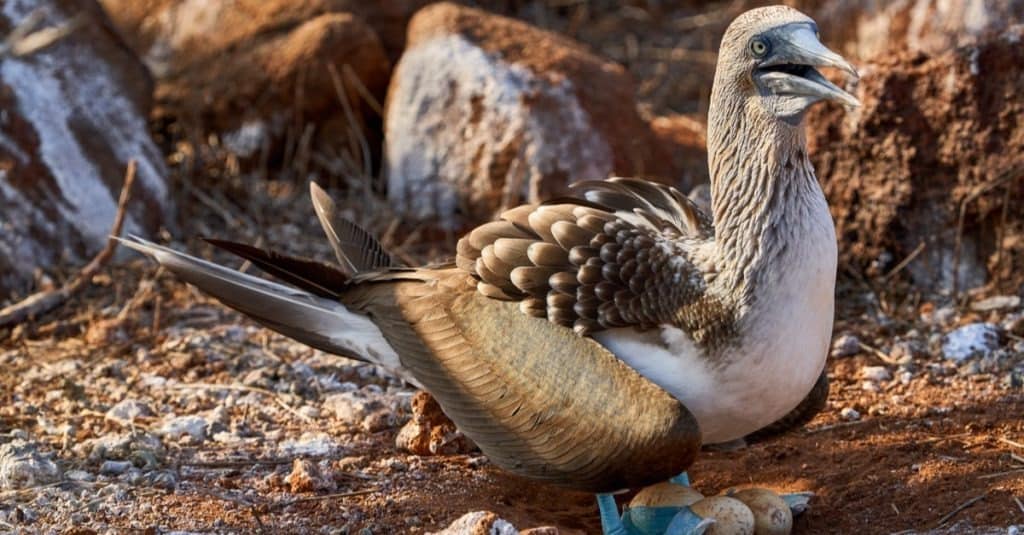
Boobies must protect their eggs diligently from potential threats.
©OSTILL is Franck Camhi/Shutterstock.com
This feathered creature is a carnivore. They are known to hunt in groups so when one spots a school of fish, they all get something to eat!
What eats booby birds?
Adult booby birds don’t have any natural predators. However, the chicks and eggs of this bird may be eaten by snakes, owls, and other larger birds.
What does the booby bird eat?
This bird eats fish including anchovies, sardines, and mackerel as well as squid. Female booby birds are able to dive deeper into the ocean than males. So, they may eat fish that are larger than the ones that males capture.
Predators and Threats
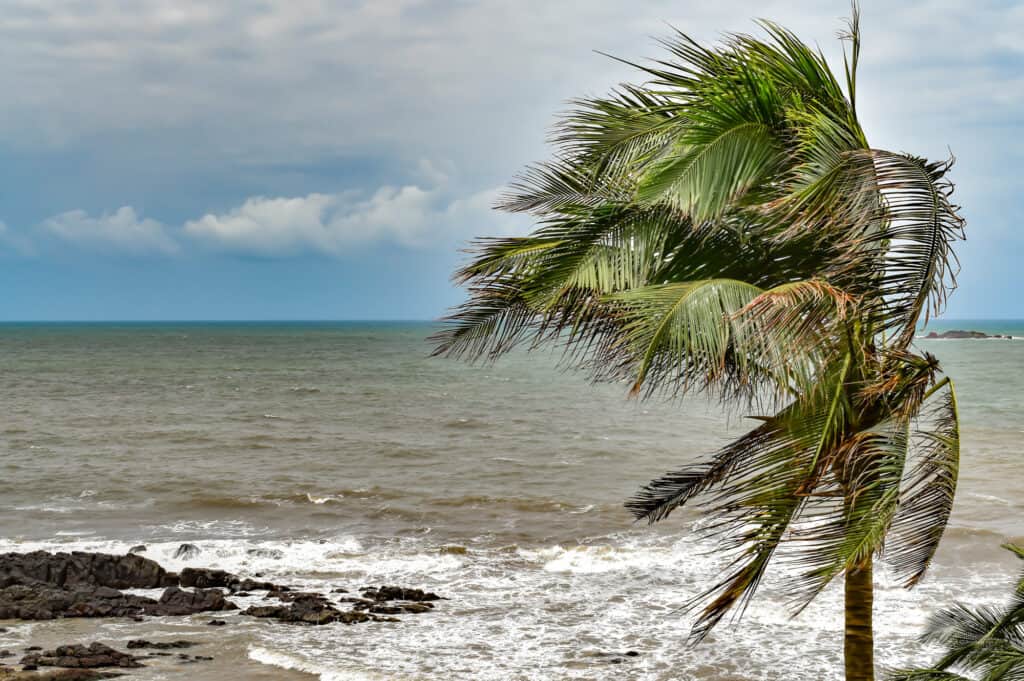
Tropical storms can adversely affect the booby bird.
©iStock.com/Ashish Kumar
While adult booby birds are mostly safe from predators, their young chicks and eggs are vulnerable. Snakes, owls, and other large birds sometimes steal young from a nest and eat them.
Water pollution created by humans is a threat to these creatures. Also, weather events such as El Nino have reduced the population of the clupeid fish. This fish is the main part of the diet of booby birds living on the Galapagos Islands.
The conservation status of the blue-footed booby is Least Concern with a stable population.
Reproduction, Babies, and Lifespan
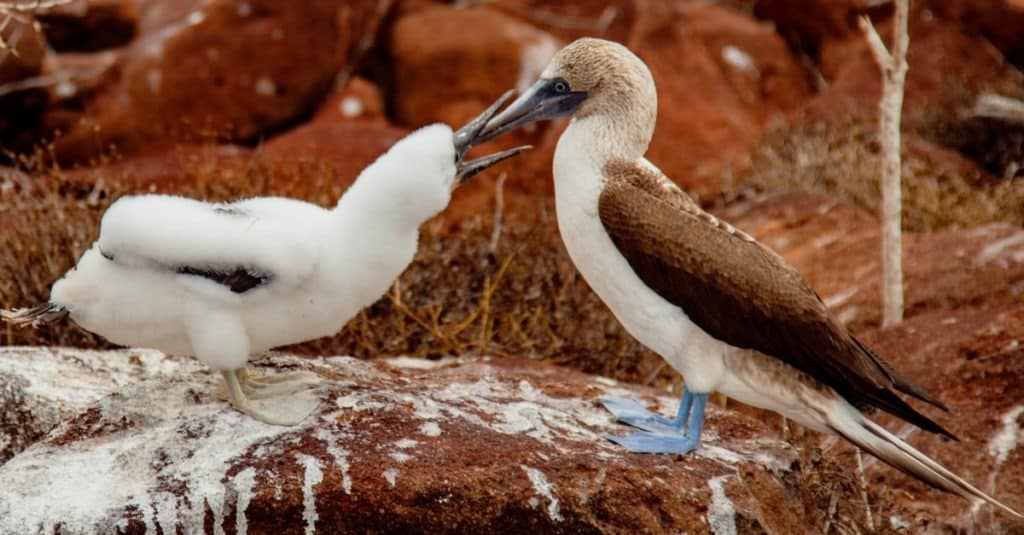
Baby blue-footed boobies do not yet display their namesake trait.
©MindStorm/Shutterstock.com
The mating season of the blue-footed booby runs from June to August. Male blue booby struts around to get the attention of a potential mate. He is sure to show off his bright blue feet! Bright blue feet or even feet that border on purple in color are a sign the bird is healthy and, therefore, a good partner. Males may also make a whistling sound for more attention. Once a female and male pair up, they stay with one another for life.
These feathered creatures make a nest on rocky ground or on a sandy spot along the coast. The nest is made in the shape of a bowl. By the time the eggs hatch, the nest has a border of feces all around it. This is because the females and males relieve themselves there at the nest in order to watch over their young.
The gestation period of these birds is 40 to 45 days. This is similar to the gestation period of the gannet which is 42 to 46 days. They usually have 2 or 3 eggs in a clutch. The eggs are pale blue in color and are usually not the same size. The mother and father take turns sitting on the nest and protecting their eggs with their colorful feet. One member of the pair finds food for the other that is guarding the nest.
Once the eggs hatch, the featherless chicks are fed by both their mother and father. They are completely dependent on their parents. Since they don’t have feathers, the chicks are vulnerable to burns from the powerful sun of the tropical environment. The parent birds use their feet to cool and protect their young. The chicks stay in the nest for 2 months. After leaving their parents, the young birds are likely to live in the same general area as their parents.
These animals can live to be around 17 years old in the wild. The record for the oldest species goes to a masked booby that lived to be 25 years old. It lived in the Pacific Ocean region.
Population
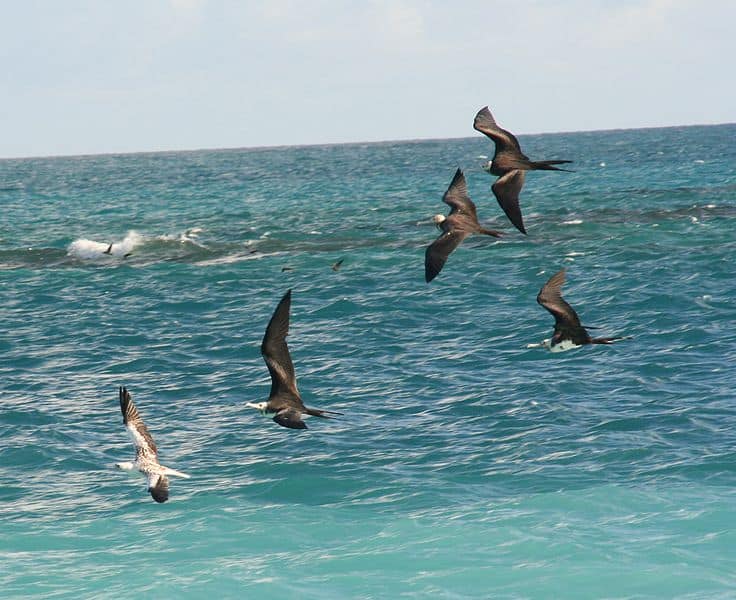
Most booby populations worldwide are in stable condition.
©Duncan Wright – Public Domain
Scientists have estimated there are from 6,000-10,000 blue-footed boobies living on the Galapagos Islands. There are believed to be approximately 2,000 masked booby birds.
Though in some areas the population of this seabird has decreased, its population is stable overall. The official conservation status of the blue-footed booby is the Least Concern.
Species
Earlier we discussed some of the different types of booby birds and their most notable characteristics, you can find a comprehensive list of all 6 species of this silly seabird below:
| Common Name | Scientific Name |
| Blue-footed booby | Sula nebouxii |
| Brown booby | Sula leucogaster |
| Masked booby | Sula dactylatra |
| Nazca booby | Sula granti |
| Peruvian booby | Sula variegata |
| Red-footed booby | Sula sula |
Booby FAQs (Frequently Asked Questions)
Are Boobies herbivores, carnivores, or omnivores?
Boobies are Carnivores, meaning they eat other animals.
What Kingdom do Boobies belong to?
Boobies belong to the Kingdom Animalia.
What phylum do Boobies belong to?
Boobies belong to the phylum Chordata.
What class do Boobies belong to?
Boobies belong to the class Aves.
What family do Boobies belong to?
Boobies belong to the family Sulidae.
What order do Boobies belong to?
Boobies belong to the order Pelecaniformes.
What genus do Boobies belong to?
Boobies belong to the genus Sula.
What type of covering do Boobies have?
Boobies are covered in Feathers.
In what type of habitat do Boobies live?
Boobies live in subtropical and tropical islands.
What is the main prey for Boobies?
Boobies prey on flying fish, sardines, anchovies, and squid.
What are some predators of Boobies?
Predators of Boobies include humans, owls, and birds of prey.
How did the booby bird get its name?
The name originated with Spanish sailors who noticed them on the shores of the Galapagos Islands. When these sailors observed the awkward movements of this seabird, they nicknamed them bobos. The word bobo means clown or fool.
Where do boobies live?
These are tropical animals living on the western coasts of Central and South America. They also live in the Gulf of Mexico, the Indian Ocean, and through the Pacific Ocean region. These animals live in a tropical climate.
How many types of booby birds are there?
There are six types of booby birds. These include the blue-footed, red-footed, brown, Peruvian, Nazca, and masked.
What do booby birds eat?
This seabird eats sardines, mackerel, anchovies, and squid.
Does the booby migrate?
No. But this seabird moves a short distance to a nesting area during the breeding season.
How many eggs does a booby lay?
They lay from 2 to 3 eggs.
How fast does a booby fly?
These animals can fly at speeds of up to 60 mph. They are really fast when diving into the ocean after a fish.
What is a booby bird’s wingspan?
The wingspan of this animal is around 5 feet. The masked booby has the largest wingspan at 5 feet 7 inches.
When do booby birds leave the nest?
The chicks stay in the nest with their parents until they are 2 months old. After they become independent, they don’t venture far from where they were born.
What are some distinguishing features of Boobies?
Boobies have large bodies and brightly colored feet.
What is an interesting fact about Boobies?
Boobies are seabirds found across the South Pacific!
What is the lifespan of a Booby?
Boobies can live for 12 to 17 years.
How do Boobies have babies?
Boobies lay eggs.
How to say Booby in ...
Thank you for reading! Have some feedback for us? Contact the AZ Animals editorial team.
Sources
- Oceana, Available here: https://oceana.org/marine-life/seabirds/blue-footed-booby
- Wikipedia, Available here: https://en.wikipedia.org/wiki/Brown_booby
- Aurora Expeditions, Available here: https://www.aurora-expeditions.com/blog/wildlife-fact-file-blue-footed-booby/

